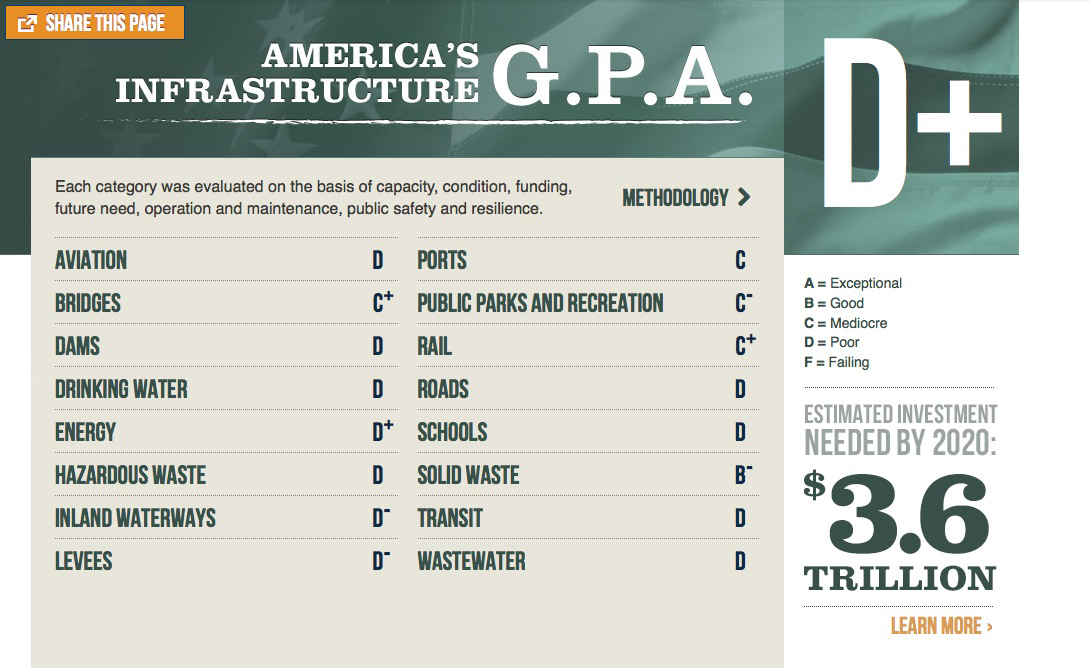AMERICAN SOCIETY OF CIVIL ENGINEERS
Executive Summary
Every family, every community and every business needs infrastructure to thrive. Infrastructure encompasses your local water main and the Hoover Dam; the power lines connected to your house and the electrical grid spanning the U.S.; and the street in front of your home and the national highway system.
Once every four years, America’s civil engineers provide a comprehensive assessment of the nation’s major infrastructure categories in ASCE’s Report Card for America’s Infrastructure (Report Card). Using a simple A to F school report card format, the Report Card provides a comprehensive assessment of current infrastructure conditions and needs, both assigning grades and making recommendations for how to raise the grades. An Advisory Council of ASCE members assigns the grades according to the following eight criteria: capacity, condition, funding, future need, operation and maintenance, public safety, resilience, and innovation. Since 1998, the grades have been near failing, averaging only Ds, due to delayed maintenance and underinvestment across most categories.
Now the 2013 Report Card grades are in, and America’s cumulative GPA for infrastructure rose slightly to a D+. The grades in 2013 ranged from a high of B- for solid waste to a low of D- for inland waterways and levees. Solid waste, drinking water, wastewater, roads, and bridges all saw incremental improvements, and rail jumped from a C- to a C+. No categories saw a decline in grade this year.
The 2013 Report Card demonstrates that we can improve the current condition of our nation’s infrastructure — when investments are made and projects move forward, the grades rise. For example, greater private investment for efficiency and connectivity brought improvements in the rail category; renewed efforts in cities and states helped address some of the nation’s most vulnerable bridges; and, several categories benefited from short-term boosts in federal funding.
We know that investing in infrastructure is essential to support healthy, vibrant communities. Infrastructure is also critical for long-term economic growth, increasing GDP, employment, household income, and exports. The reverse is also true – without prioritizing our nation’s infrastructure needs, deteriorating conditions can become a drag on the economy.
While the modest progress is encouraging, it is clear that we have a significant backlog of overdue maintenance across our infrastructure systems, a pressing need for modernization, and an immense opportunity to create reliable, long-term funding sources to avoid wiping out our recent gains. Overall, most grades fell below a C, and our cumulative GPA inched up just slightly to a D+ from a D four years ago.
We invite you to take a deeper look at the nation’s infrastructure conditions in the 2013 Report Card – from the state infrastructure facts, to the interactive charts, to our three key solutions.
 View full report (ASCE.org): The 2013 Report Card for America’s Infrastructure
View full report (ASCE.org): The 2013 Report Card for America’s Infrastructure
About the American Society of Civil Engineers (ASCE)
www.asce.org
““Founded in 1852, the American Society of Civil Engineers (ASCE) represents more than 147,000 members of the civil engineering profession worldwide, and is America’s oldest national engineering society. ASCE’s vision is to position engineers as global leaders building a better quality of life…Comprised of Regional Councils, Younger Member Councils, Sections, Branches, Student Chapters and Clubs and International Student Groups, the Society and its volunteers are fully engaged in making this a better world by design.”
Tags: American Society of Civil Engineers, ASCE, Report Card for America's Infrastructure







 RSS Feed
RSS Feed